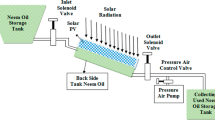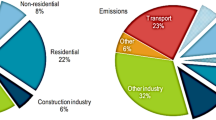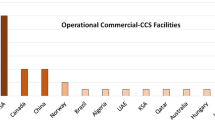Abstract
Improvements in the thermal performances of kerosene cook-stoves, which have been modified by the incorporation of radiant heat shields and a heat reuse pot, were assessed in this study. Eight test configurations, comprising different combinations of shielded/unshielded cook-stoves, conventional pots and a heat reuse pot, were experimentally assessed. The experiments followed a procedure adapted from water boiling test (WBT) protocol, which included cold-start, hot-start and simmering test phases. Using the temperatures, boiling times, and water and fuel masses obtained from the tests, the firepowers, specific fuel consumptions and thermal efficiencies of the cook-stoves were determined for the eight configurations. When processes in the conventional pot alone were considered, the greatest improvement in the efficiency \(\eta _{\mathrm{conv}}\) was obtained when radiation shields were applied to both inner and outer casings of the cook-stove (Setup V) and was up to 1.7 times the efficiency of the unmodified cook-stove setup. When processes in both conventional and heat reuse pots were considered, however, the greatest improvement in the efficiency \(\eta _{\mathrm{conv+HRP}}\) was up to 3.6 times the efficiency of the unmodified setup, and was obtained when radiation shields were applied to both inner and outer casings of the cook-stove in addition to incorporating the heat reuse pot (Setup VI). These results are indicative of the immense quantities of heat lost by radiation from kerosene cook-stove walls and by the steam vented from convention cooking pots. It has also been shown that significant improvements in kerosene cook-stove performances could be achieved by the simple measures proposed and at low cost.











Similar content being viewed by others
References
Ayub I, Munir A, Amjad W, Ghafoor A, Nasir MS. Energy-and exergy-based thermal analyses of a solar bakery unit. J Thermal Anal Calorim. 2018;133(2):1001.
Wako FM, Reshad AS, Goud VV. Thermal degradation kinetics study and thermal cracking of waste cooking oil for biofuel production. J Thermal Anal Calorim. 2018;131(3):2157.
IEA. Energy poverty: how to make modern energy access universal. World Energy Outlook, International Energy Agency, Paris (2010).
Jetter JJ, Kariher P. Solid-fuel household cook stoves: characterization of performance and emissions. Biomass Bioenergy. 2009;33:294.
MacCarty N, Ogle D, Still D, Bond T, Roden C. A laboratory comparison of the global warming impact of five major types of biomass cooking stoves. Energy Sustain Dev. 2008;XII(2):56.
Bryden M, Still D, Scott P, Hoffa G, Ogle D, Bailis R, Goyer K. Design principles for wood burning cook stoves. Shell Foundation, The Partnership for Clean Indoor AirEugene, OR: Aprovecho Research Center; 2005.
Anenberg SC, Balakrishnan K, Jetter J, Masera O, Mehta S, Moss J, Ramanathan V. Cleaner cooking solutions to achieve health, climate, and economic cobenefits. Environ Sci Technol. 2013;47:3944.
Kumar M, Kumar S, Tyagi SK. Design, development and technological advancement in the biomass cookstoves: a review. Renew Sustain Energy Rev. 2013;26:265.
Khandelwal M, Hill ME Jr, Greenough P, Anthony J, Quill M, Linderman M, Udaykumar H. Why have improved cook-stove initiatives in India failed? World Dev. 2017;92:13.
Smith KR, Dutta K, Chengappa C, Gusain PPS, Masera O, Berrueta V. Monitoring and evaluation of improved biomass cookstove programs for indoor air quality and stove performance: conclusions from the Household Energy and Health Project. Energy Sustain Dev. 2007;XI(2):5.
Bailis R, Berrueta V, Chengappa C, Dutta K, Edwards R, Masera O, Still D, Smith KR. Performance testing for monitoring improved biomass stove interventions: experiences of the Household Energy and Health Project. Energy Sustain Dev. 2007;XI(2):57.
Berrueta VM, Edwards RD, Masera OR. Energy performance of wood-burning cookstoves in Michoacan, Mexico. Renew Energy. 2008;33:859.
Malla S, Timilsina GR. Household cooking fuel choice and adoption of improved cookstoves in developing countries: a review. Policy research working paper 6903, The World Bank, Development Research Group Environment and Energy Team (2014).
IEA. Africa energy outlook: a focus on energy prospects in sub-Saharan Africa. World energy outlook special report, Paris; International Energy Agency, 2014.
Lam NL, Smith KR, Gauthier A, Bates MN. Kerosene: a review of household uses and their hazards in low and middle-income countries. J Toxicol Environ Health B Crit Rev. 2012;15(6):396.
IEA. Energy access outlook 2017: from poverty to prosperity. World energy outlook special report. Paris: International Energy Agency 2017.
Koshala R, Koshal M, Boyd RG, Rachmany H. Demand for kerosene in developing countries: the case of Indonesia. J Asian Econ. 1999;10:329.
Rao N. Kerosene subsidies in India: when energy policy fails as social policy. Energy Sustain Dev. 2012;16:35.
Sharma M, Mahanta P, Mishra SC. Usability of porous burner in kerosene pressure stove: an experimental investigation aided by energy and exergy analyses. Energy. 2016;103:251.
MacCarty N, Still D, Ogle D. Fuel use and emissions performance of fifty cooking stoves in the laboratory and related benchmarks of performance. Energy Sustain Dev. 2010;14:161.
Tyagi S, Pandey A, Sahu S, Bajala V, Rajput J. Experimental study and performance evaluation of various cook stove models based on energy and exergy analysis. J Thermal Anal Calorim. 2013;111(3):1791.
Bailis R, Ogle D, MacCarty N, Still D. The Water Boiling Test (WBT). Household Energy and Health Programme, Shell Foundation. Available from The Partnership For Clean Indoor Air at: http://www.pciaonline.org/files/WBT_Version_3.0_0.pdf (2007).
Arora P, Jain S. A review of chronological development in cookstove assessment methods: challenges and way forward. Renew Sustain Energy Rev. 2016;55:203.
Author information
Authors and Affiliations
Corresponding author
Rights and permissions
About this article
Cite this article
Njoku, H.O., Agbo, I.N., Agwuna, I.P. et al. Thermal performance improvement of kerosene cook-stoves by heat reuse and radiant heat shielding. J Therm Anal Calorim 136, 1847–1860 (2019). https://doi.org/10.1007/s10973-018-7792-8
Received:
Accepted:
Published:
Issue Date:
DOI: https://doi.org/10.1007/s10973-018-7792-8




